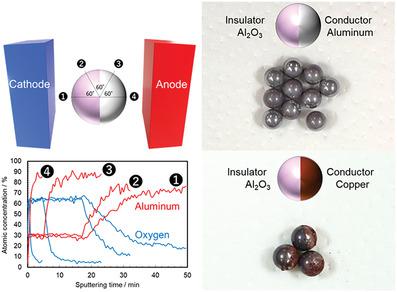当前位置:
X-MOL 学术
›
Adv. Mater. Interfaces
›
论文详情
Our official English website, www.x-mol.net, welcomes your
feedback! (Note: you will need to create a separate account there.)
Design of Multiphase Metal Balls via Maskless Localized Anodization Based on Bipolar Electrochemistry
Advanced Materials Interfaces ( IF 4.3 ) Pub Date : 2022-10-26 , DOI: 10.1002/admi.202201835
Hidetaka Asoh 1 , Kanako Mizota 1 , Yuuka Kokubo 1
Advanced Materials Interfaces ( IF 4.3 ) Pub Date : 2022-10-26 , DOI: 10.1002/admi.202201835
Hidetaka Asoh 1 , Kanako Mizota 1 , Yuuka Kokubo 1
Affiliation

|
Nanoporous metal-oxide films formed on some metals and their alloys during anodization are crucial for both basic research and commercial applications. They are used as important materials for various types of device fabrication due to their distinctive solid-state shapes, such as nanopores and nanotubes. However, preparing nanoporous films using anodization, which is a surface treatment for plate-like specimens, requires a direct electrical connection to the workpiece. Developing new materials independent of the specimen's shape and size will vary if the need for direct energization is eliminated. Here, bipolar electrochemistry is employed to fabricate two-phase (insulator–conductor) and three-phase (insulator–conductor–insulator) aluminum balls by controlling the redox reaction region in an electric field. The aluminum balls are site-selectively anodized employing a wireless and maskless operation. The multiphase aluminum balls’ versatility is demonstrated in the site-selective electroless deposition of copper on their exposed regions. Additionally, it is demonstrated that various types of materials, including aluminum and titanium, can be oxidized simultaneously in the same cell.
中文翻译:

基于双极电化学的无掩模局部阳极氧化多相金属球设计
阳极氧化过程中在某些金属及其合金上形成的纳米多孔金属氧化物薄膜对于基础研究和商业应用都至关重要。由于它们独特的固态形状,如纳米孔和纳米管,它们被用作各种类型设备制造的重要材料。然而,使用阳极氧化制备纳米多孔薄膜,这是一种板状样品的表面处理,需要与工件直接电连接。如果消除了对直接供能的需求,则开发独立于样本形状和尺寸的新材料将会有所不同。在这里,采用双极电化学通过控制电场中的氧化还原反应区域来制造两相(绝缘体 - 导体)和三相(绝缘体 - 导体 - 绝缘体)铝球。铝球采用无线和无掩模操作进行现场选择性阳极氧化。多相铝球的多功能性在铜的暴露区域上的位置选择性化学沉积中得到证明。此外,还证明了包括铝和钛在内的各种类型的材料可以在同一个电池中同时被氧化。
更新日期:2022-10-26
中文翻译:

基于双极电化学的无掩模局部阳极氧化多相金属球设计
阳极氧化过程中在某些金属及其合金上形成的纳米多孔金属氧化物薄膜对于基础研究和商业应用都至关重要。由于它们独特的固态形状,如纳米孔和纳米管,它们被用作各种类型设备制造的重要材料。然而,使用阳极氧化制备纳米多孔薄膜,这是一种板状样品的表面处理,需要与工件直接电连接。如果消除了对直接供能的需求,则开发独立于样本形状和尺寸的新材料将会有所不同。在这里,采用双极电化学通过控制电场中的氧化还原反应区域来制造两相(绝缘体 - 导体)和三相(绝缘体 - 导体 - 绝缘体)铝球。铝球采用无线和无掩模操作进行现场选择性阳极氧化。多相铝球的多功能性在铜的暴露区域上的位置选择性化学沉积中得到证明。此外,还证明了包括铝和钛在内的各种类型的材料可以在同一个电池中同时被氧化。

































 京公网安备 11010802027423号
京公网安备 11010802027423号